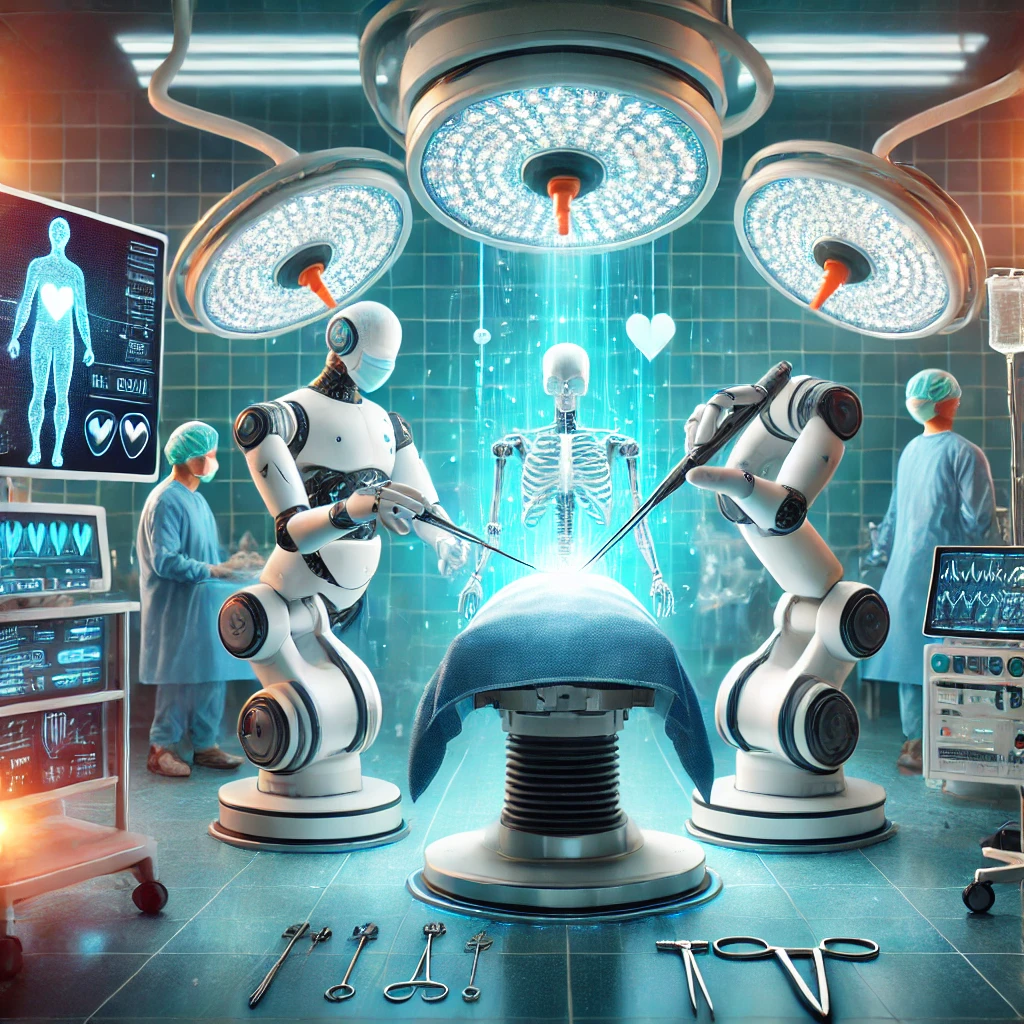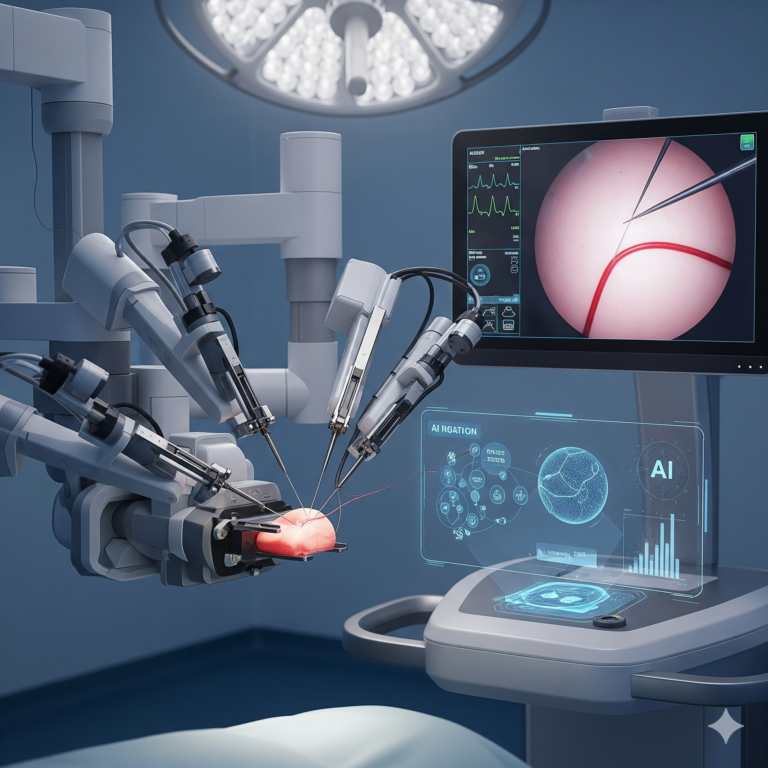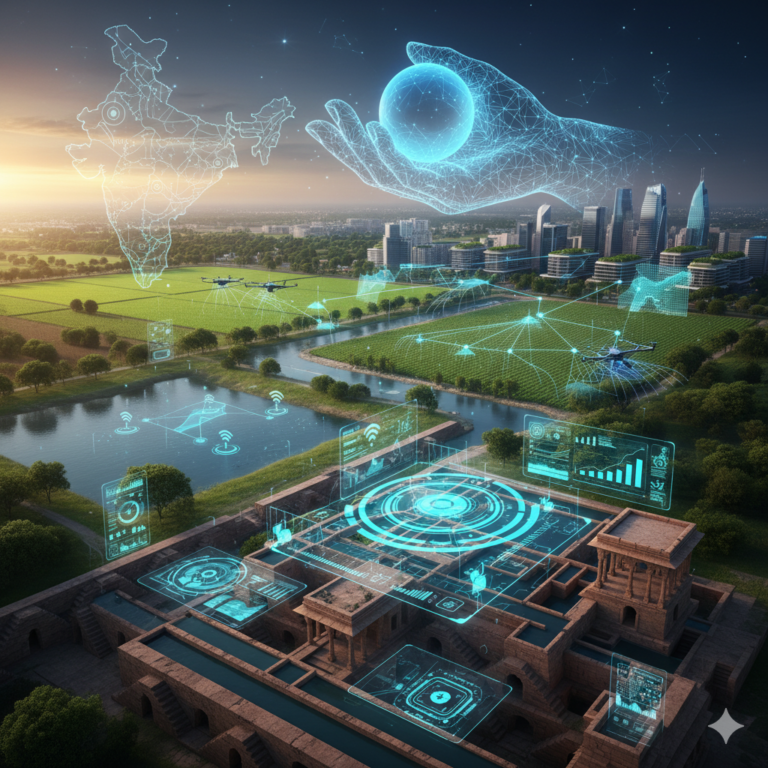Introduction: The Rise of Robotics in Healthcare
The field of medicine and surgery has undergone a massive transformation with the introduction of artificial intelligence (AI) and robotics. From robotic-assisted surgeries that offer precision beyond human capability to bionic prosthetics that restore mobility and independence, medical robotics is revolutionizing patient care.
Technological advancements have led to robots performing minimally invasive procedures, enhancing diagnostics, assisting rehabilitation, and even providing emotional support to patients. Companies like Intuitive Surgical, Medtronic, and Cyberdyne are at the forefront of these developments, ensuring that medical robotics continues to evolve.
In this article, we will explore the innovations in AI-assisted robotic surgeries and robotic prosthetics, their applications, benefits, challenges, and what the future holds for this life-changing technology.
1. What is Medical & Surgical Robotics?
Medical robotics refers to the use of robotic systems in healthcare for surgical procedures, patient rehabilitation, prosthetics, and even caregiving. These robots enhance human capabilities, reduce human error, and improve patient outcomes.
Surgical robotics, in particular, is transforming operating rooms, enabling minimally invasive surgeries (MIS), precise incisions, and improved recovery times. Meanwhile, robotic prosthetics are providing individuals with lifelike mobility and neural integration, offering a new level of control and responsiveness.
2. AI-Assisted Robotic Surgeries
AI-powered robotic surgical systems assist surgeons in performing complex procedures with enhanced accuracy. These systems are designed to mimic the dexterity of the human hand while reducing the risks associated with traditional surgeries.
A. How AI-Assisted Robotic Surgery Works
- Preoperative Planning: AI algorithms analyze patient data and medical history to create personalized surgical plans.
- Real-Time Assistance: Robotic arms equipped with AI assist surgeons with micro-precision movements.
- Machine Learning Adaptation: Over time, AI learns from past surgeries, improving its ability to predict and optimize procedures.
- Postoperative Monitoring: AI-powered robots can assist in post-surgical monitoring, reducing complications and enhancing recovery.
B. Leading AI Surgical Robots
- Da Vinci Surgical System: The most well-known robotic-assisted surgery system, used for urological, gynecological, and cardiac procedures.
- Medtronic’s Hugo RAS System: A next-generation surgical robot for laparoscopic surgeries.
- Versius by CMR Surgical: A modular robotic system that enhances precision in keyhole surgeries.
C. Applications of AI-Assisted Robotic Surgery
- Neurosurgery: AI robots perform intricate brain surgeries with minimal invasiveness.
- Cardiac Surgery: Assists in heart valve replacements and coronary bypasses.
- Orthopedic Surgery: Helps with joint replacements and spine surgeries.
- Cancer Treatment: Robotic surgeries remove tumors with high precision, preserving healthy tissue.
D. Benefits of AI-Assisted Surgery
✅ Higher Precision: AI ensures sub-millimeter accuracy, reducing errors.
✅ Minimally Invasive: Smaller incisions mean less pain and faster recovery.
✅ Reduced Surgeon Fatigue: AI handles repetitive tasks, allowing surgeons to focus on critical decisions.
✅ Better Outcomes: Enhanced precision leads to lower infection rates and fewer complications.
3. Robotic Prosthetics – Restoring Mobility with AI
While AI-driven surgical robots improve medical procedures, robotic prosthetics are transforming the lives of those who have lost limbs. These smart prosthetics are designed to mimic natural movement, respond to neural signals, and adapt to the wearer’s body.
A. How Robotic Prosthetics Work
- Brain-Computer Interfaces (BCI): Some prosthetics connect directly to the nervous system, allowing users to control movement with their thoughts.
- Machine Learning Adaptation: The prosthetic learns from user habits, refining its movements over time.
- Sensory Feedback: Advanced prosthetics restore the sense of touch, helping users feel objects.
- Exoskeleton Support: Wearable robotic exoskeletons assist people with paralysis in walking again.
B. Cutting-Edge Robotic Prosthetics
- Össur’s Bionic Leg: A prosthetic that adjusts movements automatically based on walking patterns.
- LUKE Arm by DEKA Research: An AI-powered robotic arm that allows users to control it using muscle signals.
- Cyberdyne’s HAL Exoskeleton: Assists individuals with spinal cord injuries in regaining movement.
C. Applications of Robotic Prosthetics
- For Amputees: AI-enhanced prosthetics restore mobility and fine motor control.
- For Spinal Cord Injury Patients: Exoskeletons help them walk again.
- For Stroke Rehabilitation: Robotic arms aid in muscle recovery.
D. Benefits of AI-Driven Prosthetics
✅ Improved Mobility: AI prosthetics offer natural movement and better adaptability. ✅ Enhanced Sensory Perception: Some prosthetics restore the sense of touch. ✅ Greater Independence: Helps individuals regain confidence and autonomy. ✅ Long-Term Adaptability: Machine learning helps prosthetics adjust to user habits over time.
4. Challenges & Ethical Considerations
Despite their benefits, medical and surgical robotics face several challenges:
A. High Costs
- Advanced robotic systems are expensive, making them inaccessible to many hospitals and patients.
- Robotic prosthetics can cost tens of thousands of dollars, limiting affordability.
B. Training and Skill Requirements
- Surgeons require extensive training to operate AI-assisted robots.
- Patients need time to adapt to robotic prosthetics.
C. Ethical Concerns
- The role of AI in decision-making raises questions about human oversight and liability.
- Who is responsible if a robot-assisted surgery fails?
D. Cybersecurity Risks
- AI systems are vulnerable to hacking, which could compromise patient safety.
5. The Future of Medical Robotics
As AI and robotics continue to evolve, the future of medical and surgical robotics looks promising. Advancements on the horizon include:
🔬 Smarter AI Algorithms
- AI will become even more precise, predictive, and adaptable in surgeries.
🦿 Neural-Integrated Prosthetics
- Future prosthetics will seamlessly connect with the brain, allowing for more natural movement.
🏥 Widespread Adoption in Hospitals
- AI-assisted surgeries will become the standard in healthcare.
🔐 Improved Security Measures
- Stronger data encryption will protect patient information from cyber threats.
🌍 Increased Accessibility
- As costs decrease, more patients worldwide will benefit from medical robotics.
Conclusion
Medical and surgical robotics are reshaping healthcare by offering precision, efficiency, and life-changing mobility. From AI-assisted surgeries that enhance patient outcomes to robotic prosthetics that restore independence, the future of healthcare is increasingly robotic.
Despite challenges like cost, training, and ethical concerns, continuous advancements in AI and machine learning will expand accessibility and improve patient care. As medical robotics continues to evolve, we stand at the brink of a new era in healthcare—one where technology and human expertise work together to save and transform lives.
References
- Intuitive Surgical. (2023). “Da Vinci Robotic Surgery: Innovations and Applications.”
- Medtronic. (2023). “Advancements in AI-Assisted Surgery.”
- Össur. (2023). “Bionic Prosthetics and the Future of Mobility.”
- Cyberdyne. (2023). “HAL Exoskeleton for Spinal Rehabilitation.”
- DEKA Research. (2023). “The LUKE Arm: AI-Driven Prosthetic Technology.”












[…] Medical & Surgical Robotics – The Future of AI-Assisted Surgeries and Robotic Prosthetics 🔗… […]
[…] Medical & Surgical Robotics – The Future of AI-Assisted Surgeries and Robotic Prosthetics Read here […]
[…] Medical & Surgical Robotics – The Future of AI-Assisted Surgeries and Robotic Prosthetics Read here […]